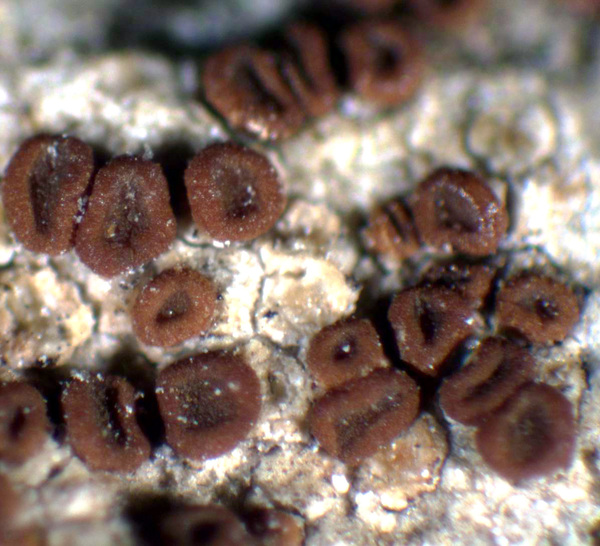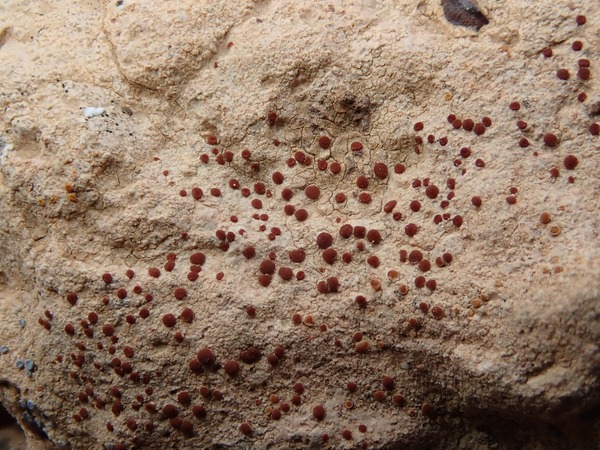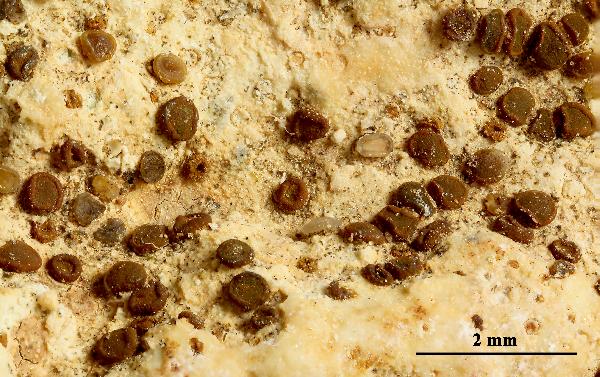Xanthocarpia fulva (Harm.) Nav.-Ros. & Cl. Roux
in Arup & al., Borziana, 4: 45, 2023. Basionym: Lecanora lactea f. fulva Harm. - Lich. Fr., 5: 863, 1913
Synonyms: Caloplaca lactea f. fulva (Harm.) Zahlbr.; Caloplaca lactea f. laetior J. Steiner; Caloplaca lactea f. rubra (B. de Lesd.) Zahlbr.; Caloplaca marmorata auct. non (Bagl.) Jatta; Gyalolechia lactea f. rubra B. de Lesd.; Xanthocarpia marmorata auct. non (Bagl.) Frödén, Arup & Søchting
Distribution: N - VG (TSB 18712), Emil (Nimis & al. 1996, Fariselli & al. 2020), Lig (GDOR 2496). C - Tosc (Benesperi 2006), Marc (Nimis & Tretiach 1999), Laz, Abr (Nimis & Tretiach 1999, Gheza & al. 2021), Sar (Brackel & Berger 2019). S - Camp (Nimis & Tretiach 2004, Garofalo & al. 2010), Pugl (Nimis & Tretiach 1999, Gianfreda & Matino 2020), Bas (Nimis & Tretiach 1999), Cal, Si (Nimis & al. 1994, Navarro-Rosinés & Hladun 1996, Grillo 1998, Caniglia & Grillo 2001, 2005, 2006, Grillo & al. 2002, 2009, Grillo & Caniglia 2004, Gianguzzi & al. 2009, Liistro & Cataldo 2011).
Description: Thallus crustose, endosubstratic, poorly visible or reduced to a few whitish granules, without a distinct prothallus. Apothecia 0.2-0.5 mm across, sessile, scattered or clustered, with a flat to slightly concave, rust-red to dark orange-red disc, and a concolorous or slightly paler, rather thin, smooth, persistent proper margin; thalline exciple absent, rarely developed only on the lower part of apothecia, finely granulose. Proper exciple prosoplectenchymatous, colourless, the outermost cells 3-5 µm wide; epithecium brownish yellow, c. 10 µm high, K+ red, C-; hymenium colourless, 80-90(-110) µm high; paraphyses mostly simple, but some of them sparingly branched in upper part, c. 2 µm thick at the base, the apical cells swollen but not globose, 5-7 µm wide; hypothecium colourless, , without crystals and oil droplets, prosoplectenchymatous. Asci 8-spored, clavate, functionally unitunicate, apically thickened with a broad internal beak, the inner part of apex and external cap I+ blue, Teloschistes-type. Ascospores 2-celled, polarilocular, hyaline, broadly ellipsoid, (12-)13.5-19(-21) x (5-)5.5-7(-8) µm, the equatorial thickening (“septum”) (1-)2-3(-3.5) µm. Photobiont chlorococcoid. Spot tests: thallus K-, C-, KC-, P-: apothecia K+ red, C-. Chemistry: thallus without lichen substances; apothecia with parietin (major), fallacinal, emodin, teloschistin and parietinic acid (minor), corresponding with chemosyndrome A of Søchting (1997).Note: a mild-temperate to xeric-continental early coloniser of calcareous pebbles in dry grasslands, overlooked or misunderstood in the past, but fairly common in Mediterranean Italy; rarer, and confined to south-exposed slopes, in the submediterranean belt. The species was previously known as Xanthocarpia marmorata, but the type of Callopisma marmoratum Bagl. (MOD-TSB) clearly belongs to the quite unrelated lichen which was formerly called “Caloplaca subochracea” (Arup & al. 2023).
Growth form: Crustose endolithic
Substrata: rocks
Photobiont: green algae other than Trentepohlia
Reproductive strategy: mainly sexual
Pioneer species
Commonnes-rarity: (info)
Alpine belt: absent
Subalpine belt: absent
Oromediterranean belt: absent
Montane belt: very rare
Submediterranean belt: very rare
Padanian area: absent
Humid submediterranean belt: rather rare
Humid mediterranean belt: common
Dry mediterranean belt: very common
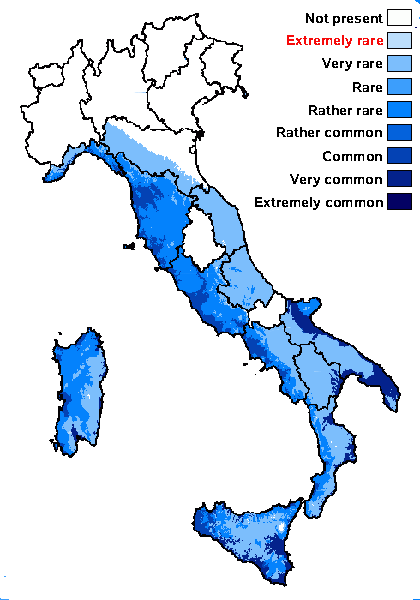
Predictive model
Herbarium samples
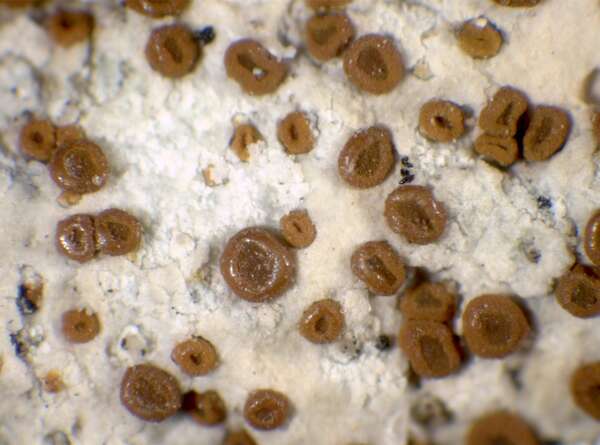

P.L. Nimis; Owner: Department of Life Sciences, University of Trieste
Herbarium: TSB (26246)
2001/12/09


Felix Schumm – CC BY-SA 4.0
[ABL 75356], The Netherlands, Prov. Noord-Holland, Holysloot, Amsterdamsezeedijk, on former seadlike on granite on shore line. Leg. et det. A. Aptroot 15.10.2016
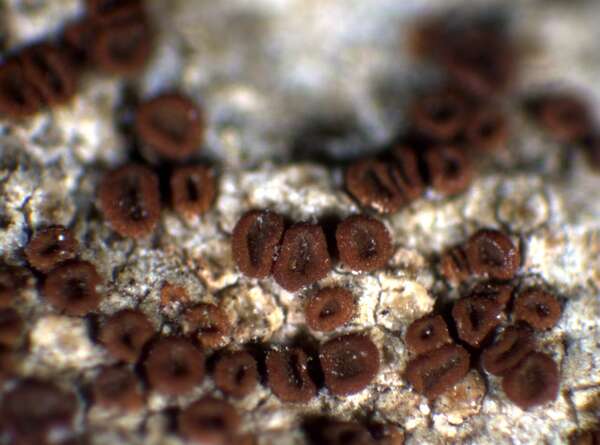

P.L. Nimis; Owner: Department of Life Sciences, University of Trieste
Herbarium: TSB (31954)
2001/11/19


Felix Schumm - CC BY-SA 4.0
[VZR42, 19556], Italia, Pelagiae insulae: insula Lampedusa, in centro
insulae, 50 m, ad lapillos calcareos in terra. Leg. P. L. Nimis, J. Poelt &
A. Vezda. EX A. VEZDA: LICHENES RARIORES EXSICCATI NR. 42. As Caloplaca marmorata
Growth form: Crustose endolithic
Substrata: rocks
Photobiont: green algae other than Trentepohlia
Reproductive strategy: mainly sexual
Pioneer species
Commonnes-rarity: (info)
Alpine belt: absent
Subalpine belt: absent
Oromediterranean belt: absent
Montane belt: very rare
Submediterranean belt: very rare
Padanian area: absent
Humid submediterranean belt: rather rare
Humid mediterranean belt: common
Dry mediterranean belt: very common

Predictive model
| Herbarium samples |


P.L. Nimis; Owner: Department of Life Sciences, University of Trieste
Herbarium: TSB (26246)
2001/12/09


Felix Schumm – CC BY-SA 4.0
[ABL 75356], The Netherlands, Prov. Noord-Holland, Holysloot, Amsterdamsezeedijk, on former seadlike on granite on shore line. Leg. et det. A. Aptroot 15.10.2016


P.L. Nimis; Owner: Department of Life Sciences, University of Trieste
Herbarium: TSB (31954)
2001/11/19


